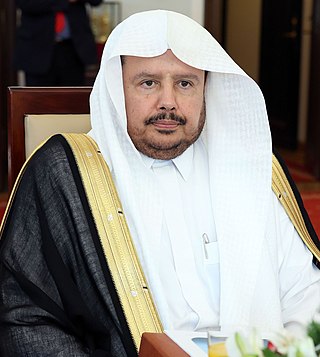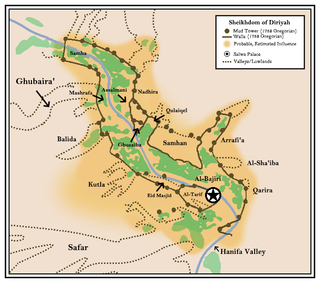Muḥammad ibn ʿAbd al-Wahhāb ibn Sulaymān al-Tamīmī was a Sunni Muslim scholar, theologian, preacher, activist, religious leader, jurist, and reformer from Najd in central Arabia, considered as the eponymous founder of the so-called Wahhabi movement. His prominent students included his sons Ḥusayn, Abdullāh, ʿAlī, and Ibrāhīm, his grandson ʿAbdur-Raḥman ibn Ḥasan, his son-in-law ʿAbdul-ʿAzīz ibn Muḥammad ibn Saʿūd, Ḥamād ibn Nāṣir ibn Muʿammar, and Ḥusayn āl-Ghannām.

The House of Saud is the ruling royal family of Saudi Arabia. It is composed of the descendants of Muhammad bin Saud, founder of the Emirate of Diriyah, known as the First Saudi state (1727–1818), and his brothers, though the ruling faction of the family is primarily led by the descendants of Abdulaziz bin Abdul Rahman, the modern founder of Saudi Arabia. It forms a subtribe of the larger prominent ancient Banu Hanifa tribe of Arabia, from which well known 7th century Arabian theologist Maslama ibn Ḥabīb originates. The most influential position of the royal family is the King of Saudi Arabia, an absolute monarch. The family in total is estimated to comprise 15,000 members; however, the majority of power, influence and wealth is possessed by a group of about 2,000 of them. Some estimates of the royal family's wealth measure their net worth at $1.4 trillion.This figure includes the market capitalization of Saudi Aramco, the state oil and gas company, and its vast assets in fossil fuel reserves, making them the wealthiest family in the world and the wealthiest in recorded history.
Abdulaziz bin Muhammad Al Saud was the second ruler of the Emirate of Diriyah. He was the eldest son of Muhammad bin Saud and the son-in-law of Muhammad bin Abdul Wahhab. Abdulaziz ruled the Emirate from 1765 until 1803. He was nicknamed by his people as the savior of his time due to his fearless activities.

Diriyah, formerly romanized as Dereyeh and Dariyya, is a town and governorate in Saudi Arabia located on the northwestern outskirts of the Saudi capital, Riyadh. Diriyah was the original home of the Saudi royal family, and served as the capital of the Emirate of Diriyah under the first Saudi dynasty from 1727 to 1818. Today, the town is the seat of the Diriyah Governorate—which also includes the villages of Uyayna, Jubayla, and Al-Ammariyyah, among others—and is part of Ar Riyad Province.
The Wahhabi war, also known as the Ottoman-Saudi War, (1811–1818) was fought from early 1811 to 1818, between the Ottoman Empire, their vassal and ally the Eyalet of Egypt, and the Emirate of Diriyah, the First Saudi State, resulting in the destruction of the latter.

The Emirate of Diriyah, also known as the First Saudi State, was established in February 1727. In 1744, the emir of a Najdi town called Diriyah, Muhammad bin Saud, and the religious leader Muhammad ibn Abd al-Wahhab signed a pact to found a socio-religious reform movement to unify the many states of the Arabian Peninsula.

The Emirate of Nejd or Imamate of Nejd was the Second Saudi State, existing between 1824 and 1891 in Nejd, the regions of Riyadh and Ha'il of what is now Saudi Arabia. Saudi rule was restored to central and eastern Arabia after the Emirate of Diriyah, the First Saudi State, having previously been brought down by the Ottoman Empire's Egypt Eyalet in the Ottoman–Wahhabi War (1811–1818).

The Unification of Saudi Arabia was a military and political campaign in which the various tribes, sheikhdoms, city-states, emirates, and kingdoms of most of the central Arabian Peninsula were conquered by the House of Saud, or Al Saud. Unification started in 1902 and continued until 1932, when the Kingdom of Saudi Arabia was proclaimed under the leadership of Abdulaziz, known in the West as Ibn Saud, creating what is sometimes referred to as the Third Saudi State, to differentiate it from the Emirate of Diriyah, the First Saudi State and the Emirate of Nejd, the Second Saudi State, also House of Saud states.
The Al ash-Sheikh, also transliterated in a number of other ways, including Al ash-Shaykh, Al ash-Shaikh, Al al-Shaykh or Al-Shaykh is Saudi Arabia's leading religious family. They are the descendants of Muhammad ibn Abd al-Wahhab. In Saudi Arabia, the family is second in prestige only to the Saudi royal family, the Al Saud, with whom they formed a power-sharing arrangement nearly 300 years ago. The arrangement, which persists to this day, is based on the Al Saud maintaining the Al ash-Sheikh's authority in religious matters and the Al ash-Sheikh supporting the Al Saud's political authority.

Abdullah ibn Muhammad Al ash-Sheikh is the chairman of the Majlis ash-Shura of Saudi Arabia since February 2009. He was the minister of Justice from February 1992 to February 2009.

Muhammad bin Saud Al Muqrin, also known as Ibn Saud, was the emir of Diriyah and is considered the founder of the First Saudi State and the Saud dynasty, which are named for his father, Saud bin Muhammad Al Muqrin. His reign lasted between 1727 and 1765.
Saud bin Muhammad Al Muqrin was the eponymous ancestor of the House of Saud, otherwise known as the al-Saud.
Imam Sulaymān ibn ‘Abd al-Wahhāb at-Tamīmī was an Islamic scholar, Hanbali jurist, and theologian from the Najd region in central Arabia. He was the elder brother of Muhammad ibn Abd al-Wahhab, the founder of the Wahhabi movement, and he was one of the first critics of his brother and the Wahhabi movement. He considered the Wahhabi doctrine a heresy and it is likely that he was the first to use the word "Wahhabi" to refer to his brother's doctrine in his alleged treatise The Unmistakable Judgment in the Refutation of Muhammad ibn 'Abd al-Wahhab.
Abdullah bin Muhammad Al Sheikh (1751–1829) was a Muslim scholar who served as the head of the judicial system during the First Saudi State, also known as the Emirate of Diriyah. He was a son of Muhammad ibn Abd al-Wahhab, who was credited with introducing the Wahhabi sect of Islam. Abdullah developed the doctrine of this religious belief. David Commins, an American scholar on Wahhabism, argues that Abdullah was the most significant son of Muhammad.

The Sheikhdom of Dir'iyah, was a polity in central Arabia from 1446 to 1744 and the predecessor to the First Saudi State. Its capital was Al-Turaif District, and it was based around the banks of Wadi Hanifa. It was ruled by the Muani'a dynasty from the Durou' clan, and later under its two branches, Muqrin and Watban, with the former becoming the sole house and the house from which the House of Saud descends.

Al-Hukm Palace, also known as the al-ʽAdl Palace, so called from the public square it overlooks from the south, is a historic palace and a popular cultural heritage landmark in the ad-Dirah neighbourhood of Riyadh, Saudi Arabia, located directly opposite to Imam Turki bin Abdullah Grand Mosque in the Qasr al-Hukm District. It is the historic site where tribal leaders and members of the Saudi royal family have been pledging allegiance to the country's political leadership. Built in 1747, it was known as Ibn Dawwas Palace until the 1820s, when Turki bin Abdullah, after gaining control of Najd, shifted the royal family's center of power from Diriyah to the walled town of Riyadh due to the former's severe destruction in a brutal siege during the Ottoman–Wahhabi War of 1818 as well as the town’s Ottoman sacking in 1821.

Saudi Founding Day, officially the Founding Day, is a public holiday in Saudi Arabia celebrated annually on February 22 to commemorate the enthronement of Muhammad bin Saud as the emir of the oasis town of Diriyah in 1727 following the death of his father Saud al-Muqrin, the eponymous ancestor of the al-Saud family. His hereditary succession is considered as the prelude to the inception of the First Saudi State, the antecedent to the Second Saudi State and present-day Kingdom of Saudi Arabia. It was founded in 2022 on its 295th anniversary when King Salman bin Abdulaziz issued a royal decree that designated it as a legal holiday to be observed as per the Gregorian calendar. It is one of the three non-religious national holidays observed in the country, other being the Saudi National Day and Saudi Flag Day.
The Expedition to Riyadh, was a conflict made by the Emirate of Diriyah against the tribes of Riyadh for an expansion, this lasted more than 28 years.
Sheikh Muhammad bin Ibrahim Mosque is a Friday mosque and an active place of worship in the ad-Dirah neighborhood of Riyadh, Saudi Arabia, located south of Souq al-Zal in the Qasr al-Hukm District. It was first established in 1773 as Dakhna Grand Mosque in the Dakhna quarter and later got evolved into a center of learning for Hanbali Sunni scholars. Named after Muhammad ibn Ibrahim Al ash-Sheikh, it is the oldest existing mosque in Riyadh and was demolished and rebuilt on numerous occasions throughout the 20th century, with the latest renovation having taken place in the period 2001–2005 during the third phase of the Qasr Al Hukm District Development Project.

The walled town of Riyadh was the original core of Riyadh, the modern-day capital of Saudi Arabia, located on the western edge of Wadi al-Batʼha in present-day neighborhoods of ad-Dirah and ad-Doho. It succeeded from Migrin in 1746 when Daham bin Dawwas erected a wall around it, built a palace for himself and ruled as the settlement's chieftain until his overthrow by the First Saudi State in 1773. It was later the center of power of the Second Saudi State for most of 19th century following brief Ottoman presence in Najd. Abdulaziz ibn Saud captured the town in 1902 and made it the base for his 30-year long unification wars that led to the establishment of Saudi Arabia in 1932. The town served as the administrative center of the Saudi government until 1938, when Ibn Saud moved his workplace and residence to Murabba Palace. In 1950, he instructed the dismantling of the fortifications in order to expand the settlement into a metropolis and the walled town eventually ceased to exist. The area covering the perimeters of the erstwhile town was renamed as the Qasr al-Hukm District in 1973 with the aim of preserving its historical and architectural significance.











